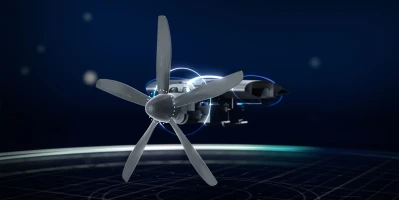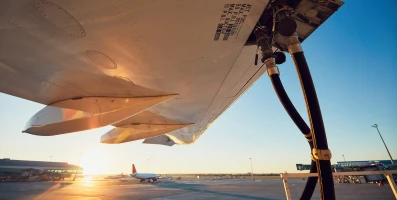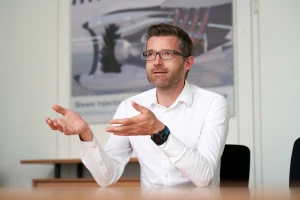people
Will air taxis be a game-changer?
Dr. Kay Plötner from Bauhaus Luftfahrt, a think tank, analyzes the opportunities and challenges of using air taxis sustainably, especially electric vertical takeoff and landing aircraft.
author: Nicole Geffert | 5 mins reading time published on: 05.12.2023
author:
Nicole Geffert
has been working as a freelance journalist covering topics such as research and science, money and taxes, and education and careers since 1999.

Less congestion, lower CO₂ emissions, and enhanced mobility in cities and conurbations: the expectations placed on urban air mobility (UAM) are high. All over the world, established companies and start-ups are working on air taxis—especially on electric vertical takeoff and landing (eVTOL) models—and hoping that these small aircraft will turn into big business. But how realistic is this vision? Dr. Kay Plötner, Head of Economics and Transportation and expert in urban and regional air mobility at Bauhaus Luftfahrt, a think tank, talked to AEROREPORT about the outlook for these new aircraft.
Dr. Kay Plötner, Head of Economics and Transportation Bauhaus Luftfahrt.




Prior to joining Bauhaus Luftfahrt in 2010, Dr. Kay Plötner completed his degree and doctorate in aerospace technology at the Technical University of Munich. Since 2016, he has served as Head of Economics and Transportation at Bauhaus Luftfahrt, where he and his team plot the potential future development of the air transport system and identify key drivers at the socioeconomic, political, and ecological level. They research promising integrative solutions for urban and rural areas around the world, taking into account aspects such as economics, ecology, fairness, and urban planning.

AEROREPORT: Dr. Plötner, what is urban air mobility?
Kay Plötner: Urban air mobility is a transport system for passengers, freight, and services in and between cities. In addition to smaller drones, air taxis—especially eVTOL models—play a central role in this concept. Thanks to new technologies such as electric propulsion systems and enhanced battery capacity, VTOL systems are becoming a viable option. These aircraft carry out similar functions to those of helicopters, but are quieter and more economical to operate.
AEROREPORT: Bauhaus Luftfahrt sees urban air mobility as a supplement to conventional modes of transportation, not as a replacement. Your position is that air taxis will not be a game-changer for urban mobility. Why not?
Plötner: Urban air mobility’s potential time advantage over driving exists really only in extremely congested areas and under the proviso that the vertiports can be reached and accessed easily. Vertiports are special takeoff and landing points for eVTOL aircraft; these require sizeable infrastructure on the ground and have yet to be planned, financed, and established. For a vertiport to serve around 100 customers per hour, it would have to be the size of a soccer field. But vertiports will be very limited in size and number due to a shortage of space—in cities, space is tight and precious—as well as for reasons of noise pollution and safety.
AEROREPORT: Could air taxis go a long way toward easing congestion on the roads?
Plötner: It’s unlikely that air taxis will solve the problem of congestion in cities because only a select group of people will be able to afford to ride in air taxis on a regular basis. eVTOL aircraft can transport only small payloads and typically offer four to six seats. The predictably high fare must then be split among a small number of passengers. Most UAM studies estimate that in the long term, air taxis will achieve a 1 percent market share, particularly due to high investment costs for aircraft, infrastructure, and staff. It’s likely that the first air taxis will be piloted rather than automated. Given this low market share, urban air mobility is not expected to achieve a noticeable reduction in congestion on the roads.
You may also be interested in following content
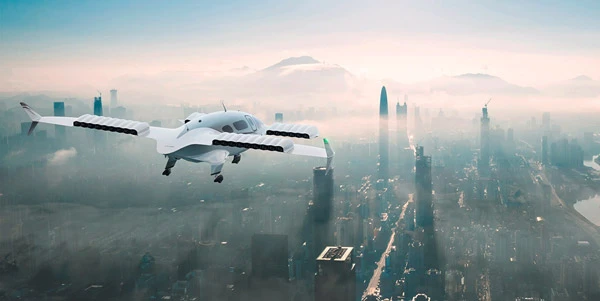
©Lilium
Developments in eVTOL: What lies ahead for air taxis and drones?
AEROREPORT: Does urban air mobility offer an ecological benefit?
Plötner: The only way air taxis could reduce CO₂ emissions would be if they replaced journeys currently made in cars powered by combustion engines. Since vertical takeoff and landing aircraft represent the most energy-intensive way to fly, the power consumption and necessary battery mass is much higher than for electric cars. This means that in most scenarios, air taxis are less resource-efficient than other electric modes of transport. Another aspect to consider is noise emissions. It’s scientifically proven that high noise levels can adversely affect the health and quality of life of urban populations. European cities in particular will not tolerate high noise levels.
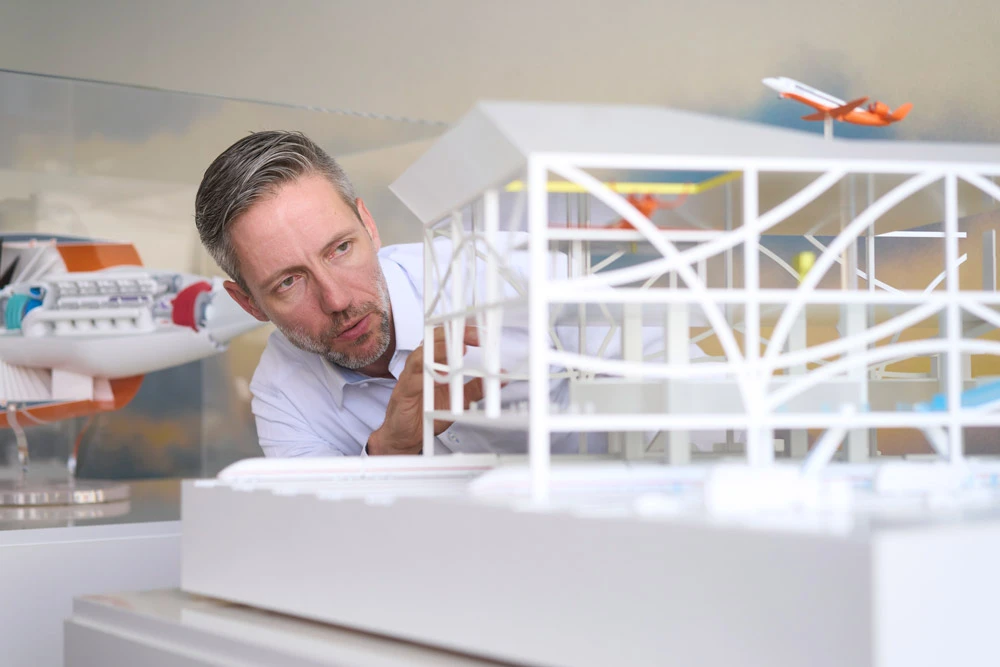
„CenterAirStation“: The concept of this downtown airport aims to significantly increase the capacity of the air transportation system by shifting existing and future city connections from conventional airports to this type of urban air hub. CenterAirStation was developed by Bauhaus Luftfahrt together with students from the Glasgow School of Art.
AEROREPORT: Several eVTOL manufacturers are already heading for the runway. Volocopter, for instance, wants to offer passenger services during the 2024 Olympic Games in Paris. What do you make of this development?
Plötner: It will surely be an attraction for visitors. Although we expect eVTOL aircraft to remain a niche product, there are attractive business models out there for manufacturers and operators. Even if air taxis occupy a niche, the production of eVTOL aircraft could surpass current helicopter production should air taxis demonstrate lower overall costs or noise emissions. Aviation always performs particularly well when it comes to covering great distances or when there’s no efficient way of getting from A to B by land or sea. In regions characterized by certain geographic obstacles like islands or mountains, air taxis could provide real value to people by reducing travel times and increasing accessibility.
AEROREPORT: Are there other ways that urban air mobility could improve people’s quality of life?
Plötner: Air taxis could appeal to certain user groups, such as tourists or business travelers, who are prepared to pay for a special experience or time advantage. eVTOL aircraft could also serve as feeders for long-haul flights as a quick and convenient way of transporting passengers to and from airports and hubs. Urban air mobility also has value to offer when it comes to paramedic call-outs or transporting lifesaving equipment or drugs. And beyond commercial passenger transportation, there are any number of applications in freight and support services.


Bauhaus Luftfahrt was founded as a registered association in 2005. It is a nonprofit research institution and derives its name from the original Bauhaus in Dessau. Its members are four renowned aviation companies—Airbus, IABG, Liebherr-Aerospace, and MTU Aero Engines—as well as the Bavarian State Ministry of Economic Affairs, Regional Development, and Energy. The German Aerospace Center (DLR) was added as a funding member in 2020.

AEROREPORT: You say that turning urban air mobility into a future-proof concept hinges on identifying social, ecological, and economically sustainable applications. What exactly does that mean?
Plötner: It means applications will have to cater to the needs and expectations of users and society, minimize the environmental fallout, and demonstrate viability. Looking to Europe, applications should be designed using co-creative processes—in other words in collaboration with a variety of interest groups. The goal is to establish a fair, sustainable transport system that better connects rural areas with major cities. Achieving this will mean promoting both research and development activities and a close collaboration among industry, politics, and society.
„20 years from now, we’ll be able to look up and see new kinds of aircraft and other flying machines that employ a wide range of technologies.“
Head of Economics and Transportation and expert in urban and regional air mobility at Bauhaus Luftfahrt, a think tank
AEROREPORT: What’s the latest on other concepts like regional air mobility?
Plötner: For urban air mobility we’re talking about distances of 20, 30 or 50 kilometers, perhaps more. This soon crosses over into the world of regional air mobility, which could also be based on aircraft powered by batteries or hydrogen. These aircraft could transport 19 or more passengers at a time using the existing infrastructure of regional airports. But to establish this kind of new regional air mobility, it will take more than simply developing, certifying, and producing new aircraft. One key precondition is to have in place the infrastructure for battery charging and hydrogen refueling. The aviation industry is changing, but one thing is clear: 20 years from now, we’ll be able to look up and see new kinds of aircraft and other flying machines that employ a wide range of technologies.



